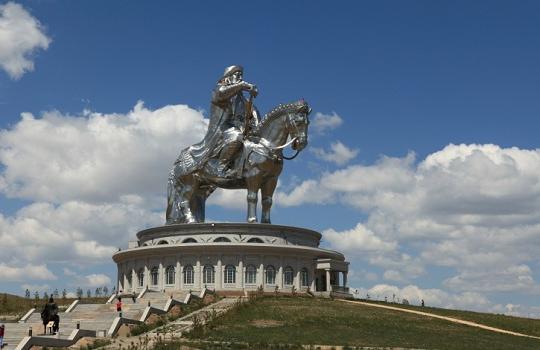It’s August 1227, in a remote valley in Liupan Mountains, in what is today north-central China. Genghis Khan, perhaps the greatest conqueror the world has ever seen, lies dying. Over the previous 40 years he had risen from almost nothing to found a nation (Mongolia) and lead his nomadic cavalry to seize much of north China and half the world of Islam. It is already the world’s biggest land empire, and it is only half formed.
His grandson Kublai Khan will double it again, taking all of China, while relatives advanced across the rest of the Middle East and all southern Russia, briefly occupying Hungary, even sending scouts to the gates of Vienna. One sixth of the world’s land area, all under the control of a single family – this is surely one of history’s most astounding achievements.
The inspiration? Genghis’s vision that the whole world would eventually fall to the Mongols. Yet on that day in a remote Chinese valley, all was at risk, for if Genghis’s enemies learned of his fatal illness, they would take heart, resist, and the vision would come to nothing. His commanders and family knew what had to be done. Of his death not a word leaked out. His body was spirited back across the Gobi to his homeland, and given a secret burial.
It is still secret. The conquests continued, the empire endured, until in his old age Kublai discovered the true nature of the world and the impossibility of achieving his grandfather’s aim. The Empire died in 1368, when the Mongols were booted out of China by Ming rebels.
Meanwhile, the Mongols, their subjects, their victims and countless millions since were left with a mystery: how on earth had Genghis managed it? To the Mongols the answer was obvious. Heaven was on his side. To us, today, the answer lies in the nature of his leadership, which, thanks to modern leadership theory, can be analysed.
Let’s take a closer look.
There are two dimensions to Genghis as leader: the particular and the general. He was, like his empire, unique; a character rooted in time and place. But he also had qualities that apply much more widely, making him in many ways a leader, if not for all time then at least for many times.
He was of his time in two ways:
- His belief in Heaven’s backing: It’s a historical commonplace for rulers to claim divine support. But they limit the claim to their own people, nation or empire (as Chinese emperors did). Religious leaders have often aimed to spread their word universally, but world rule is reserved for world’s end. Yet Genghis himself probably believed, and his heirs certainly did, that Heaven really had given the world to them, and their job was to have everyone acknowledge this. With hindsight, it’s completely crazy. But since at the time no one, let alone a Mongol, had any idea of what the world was like and how impossible the vision was, the belief was a vital element in Genghis’s charismatic appeal.
- Focused ruthlessness: There have been genocides, attempted genocides, massacres and outrages galore; but never anything like those unleashed by Genghis and his heirs. He achieved what others could only dream of: annihilation of those who opposed him. First in line were enemy clans and tribes; then many enemy cities. Millions died. But unlike many modern genocides, this was not racist. True, Mongols considered themselves the top nation among lesser breeds. But three factors limited the spirit of destruction. First, Genghis appreciated talent, of whatever ethnic background. Second, his prime purpose was universal and eternal rule, which is hard to achieve with devastated lands and alienated populations. Third, this meant that his aim was purely strategic – to force capitulation. Opposition meant death, but (vengeance apart) surrender meant life as part of Genghis’s Heaven-backed empire.
These two important elements in his leadership are, I suggest, unique to him and of his time. They would not apply in any of the ways in which leadership is exercised in the modern world.
Other traits do apply. Here is a quick survey of those elements of Genghis’s leadership that might be envied by leaders today:
Genghis controlled his image – becoming in effect his own spin-doctor – by vetting the stories recorded about him (mainly in the Mongols’ foundation epic, The Secret History of the Mongols). He had a rare ability to accept criticism; he kept his word; he encouraged and rewarded loyalty; he shared his army’s hardships, insisting on his austere nomadic roots; unlike his compatriots, he saw the dangers of alcohol (‘A drunkard is like one who is blind, deaf and insane,’ he is supposed to have said); he rejected luxury; he recognized his own limitations (for instance, although illiterate, he saw that government demanded literacy, and introduced a script); he gave clear rules, and stuck to them; he was a realist, but also when necessary a risk-taker; he had no interest in gratuitous violence against individuals – there is no record of torture under Genghis (though his heirs sometimes disgraced themselves by using it).
Genghis had a remarkable lack of ego, equating his interests with those of the state, but putting the state first; he chose an heir (a challenge that many lesser bosses never face); he employed talent wherever he found it, never mind the ethnic background, employing Muslims, Chinese, Khitans, and Uighurs; he was magnanimous, even to enemies; he was meticulous in planning; he was a deep thinker, as his relationship with both his top minister (a Chinese) and a famous Chinese priest showed; he was tolerant of different religions (well, sort of: the Mongols just didn’t care what beliefs you had as long as you served the Mongol cause) ; and finally – perhaps the most surprising trait in a world conqueror – he was never arrogant, displaying remarkable humility in the face of the immensity of the task which, for whatever incomprehensible reason, had been imposed on him by Heaven.
To come at the matter from another direction, many of these traits are elements in what Daniel Goleman, one of the most successful of leadership theorists, calls ‘emotional intelligence’. In The New Leaders, Goleman and his co-authors list 18 so-called ‘competencies’ that are displayed by top leaders:
Personal competencies:
- Emotional self-awareness
- Accurate self-assessment
- Self-confidence
- Self-control
- Integrity
- Adaptability
- Drive
- Initiative
- Optimism
Social competencies:
- Empathy
- Organisational skills
- Commitment to service
- Inspiration
- Persuasiveness
- An interest in cultivating the abilities of others
- Recognising the need for change
- Conflict management
- Teamwork
Effective leaders, he said, display four of them; highly effective ones display six or more. There is no totally convincing way to compare present-day requirements with those needed 800 years ago, but Genghis can be said to have had 15 of the 18. However you assess him, Genghis ranked as a leader of genius.









